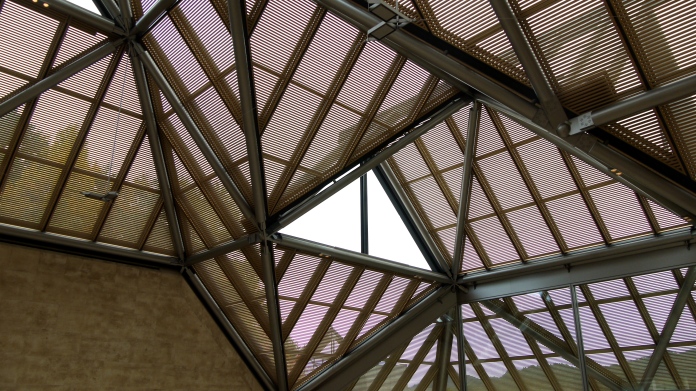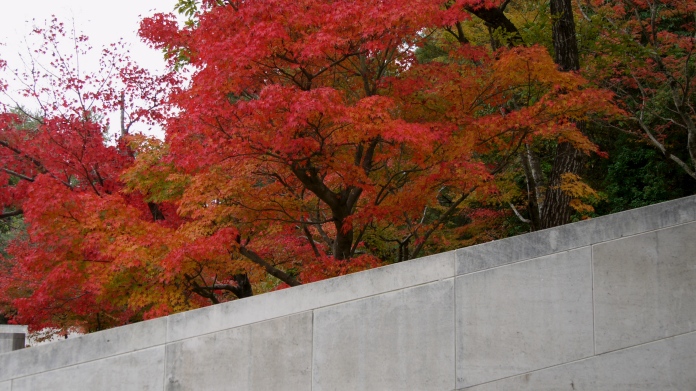Autumn is absolutely the best season to travel in Japan, and with my dad visiting from America, the beginning of November also offered me an (unwittingly) willing travel companion. Thinking fondly of my trip to the Adachi Art Museum last autumn, I persuaded my dad to hop on one train, then another and then a bus with me to the Miho Museum in Shiga prefecture.
The museum is tucked well away in the Shigaraki Mountains, about an hour southeast of Kyoto, and despite the inadequate leg space provided on the various buses and trains we rode that day, I think we both came away from the museum feeling it was well worth the long, winding road there.
The museum houses in magnificent, yet elegant style, the superb collection of Mihoko Koyama, the heiress of a textile business, one of the wealthiest women in Japan, and incidentally the founder of a spiritual movement, Shinji Shumeikai (神慈秀明会)…I hope you’re still following. According to my thorough online (Wikipedia) research, there are 300,000 Shumei adherents, who among other things, believe that the Earth’s balance can be restored by building architectural masterpieces in remote locations. Enter I. M. Pei and the Miho Museum.
The museum is breathtaking, and indeed, its beauty does seem to derive from the union of fantastic architecture and sublime landscape. However, as you enter the museum vicinity through a gorgeous tunnel, which quietly pierces through the rugged side of a mountain and behold the central pavilion of the museum, preceded by a mini suspension bridge spanning the valley below, it becomes all too clear that this well-endowed architecture owns the landscape.
To say that the museum design was borne from the ancient Chinese tale of the Peach Blossom Spring perhaps conveys the grandeur of the museum’s concept and realisation; in this tale written over 1000 years ago a lost fisherman stumbles upon a grove of blossoming peach trees and, pursuing a ray of light through a nearby cave, winds up in the paradisiacal land of immortals. Having compelled generations of Chinese landscape artists to pursue ever-greater pictorial expression, this utopia finally materialised in the mountains of Japan through the vision of I. M. Pei and his patroness. Even seen in the antonymous season of autumn, the museum and its surroundings were ethereal, and the collection within offered even more.
Sadly I have no photos to describe the wonders within the museum; but as a visitor I’m always glad to be made to shelve my camera in favour of my eyes. The permanent collection, largely amassed by Koyama during the 1990s, is shockingly beautiful, so much so that when the museum opened, many questioned the authenticity of its pieces. The jewel-like quality of the artworks, some of which date back to the second millennium B.C., does defy belief. Solid gold vessels and jewellery lavishly inlaid with lapis lazuli adorn the West Asian galleries, while in the Chinese rooms, entitled ‘In Quest of Eternal Bliss’, visitors are spoilt by a beautifully curated collection of rare treasures cast in bronze and carved in stone.
Although the collection is vast, the displays are sparse. Pieces have clearly been carefully chosen and painstakingly displayed so that you have no choice but to marvel at the handiwork of millennia of Egyptian, Asian, Greek, Roman, Chinese and Islamic artisans. Having spent a year with the British Museum on the doorstep of my university campus, I thought I was virtually immune to the splendour of the ancient world, but the Miho museum really took my breath away.
The pursuit of beauty through art and the appreciation of nature can be tiring activities, particularly when you’ve travelled three hours to even begin, but fortunately for us the Shumei spiritual movement also believes in ‘natural agriculture’, and therefore the museum cafe offered exquisite plates of locally sourced, delicious organic sandwiches.
The scope of the museum collection may be global, but its architecture and its sandwiches are delightfully Japanese. The open, central spaces of the museum, crowned with pristine glass roofs, crisply folded into geometric shapes like origami, offer a generous view of the tree-covered mountains that extend towards the horizon. As I’m sure my granddad would agree, a day out is never complete without a few sarnies and a good view. With the latter well in hand, I can further attest to the fact that it is significantly enriched when these sarnies are transformed into delightful morsels of slivered vegetables and cocoa infused cream cheese. When in the Peach Blossom Spring…







